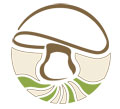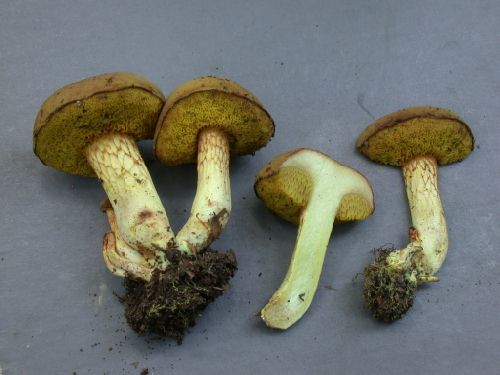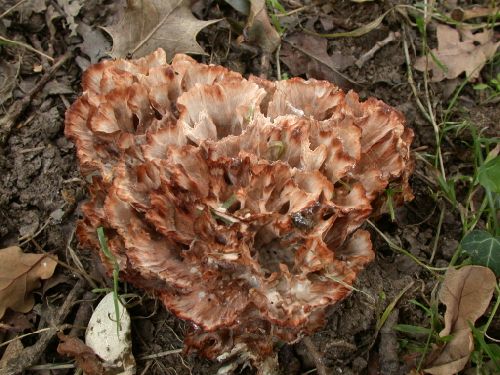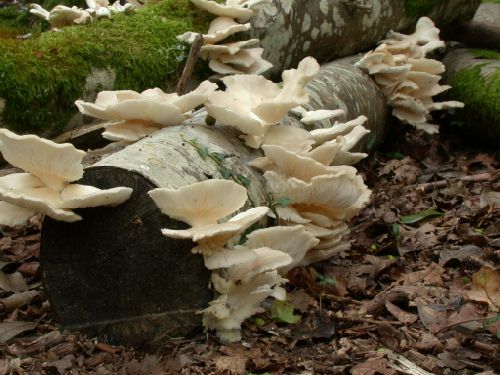New Forest: Eyeworth Wood
Sat 22 Aug 2009
Field event ID HF0909
OS Grid areas: SU2214 SU2215
Weather: The previous week had seen a few showers but only enough to dampen the ground. The day itself was virtually dry with some sunny spells.
New Records:
New to Hampshire: Mycogone rosea
New to HFRG: Xerocomus chrysonemus, Tomentella badius
Report: The group was filled with expectation after the visit to the new site at Curbridge last week. We set out to see if the Piptoporus quercinus (Oak Polypore) was still in evidence after it was found here for the first time last year when it was noticed on the way back at the end of a day's outing. The fallen branch was found to be producing about six fruitbodies most of which were now past their sell by date as their peak fruiting time is the end of July. However they were still recognisable and the pores showed the characterstic wine red colour change when bruised. Shortly afterwards Podoscypha multizonata, another New Forest speciality, turned up looking as it does like a pink cabbage plant. South Hampshire has three times as many records as the two next counties of Berkshire and South Essex. Roger found a fruitbody covered with a bright pink mold which turned out to be Mycogone rosea, a new Hampshire record. The find of the day has to go to a bolete found by Add near the end of the day. It looked somehow different with its yellow mycelium and flesh and was recognised by Alan to be the recently described species Xerocomus chrysonemus. The reference specimen to identify the species to the world (type specimen) was found at Pig Bush in the New Forest in 2003 by Steve Kelly and was formally described by Andy Taylor, Alan Hills and others in 2006. This is a totally new site for the species. What a day to remember, one that should have satisfied everyone's apetite.
Species list: Amanita excelsa var. spissa, Amanita fulva, Amanita rubescens var. rubescens, Biscogniauxia nummularia, Bjerkandera adusta, Boletus badius, Boletus cisalpinus, Boletus reticulatus, Botryobasidium aureum, Bulbillomyces farinosus, Cantharellus cibarius, Ceriporia excelsa, Ceriporiopsis gilvescens, Chlorociboria aeruginascens, Crepidotus applanatus var. applanatus, Daedaleopsis confragosa, Daldinia concentrica, Fistulina hepatica, Fuscoporia ferrea, Ganoderma australe, Gloeoporus taxicola, Gymnopus dryophilus, Gymnopus fusipes, Gyroporus castaneus, Heterobasidion annosum, Hydnum repandum, Hygrophoropsis aurantiaca, Hymenochaete rubiginosa, Hyphoderma setigerum, Hypholoma fasciculare var. fasciculare, Inonotus cuticularis, Laccaria laccata, Lachnum virgineum, Lactarius azonites, Lactarius chrysorrheus, Lactarius quietus, Lactarius tabidus, Laetiporus sulphureus, Leccinum crocipodium, Lenzites betulina, Marasmius rotula, Megacollybia platyphylla, Meripilus giganteus, Mycena haematopus, Mycoacia nothofagi, Mycogone rosea, Orbilia xanthostigma, Panellus stipticus, Paxillus involutus, Peniophora quercina, Peniophorella pubera, Phaeohelotium nobile, Piptoporus betulinus, Piptoporus quercinus, Pleurotus ostreatus, Pluteus cervinus, Pluteus salicinus, Podoscypha multizonata, Polydesmia pruinosa, Polyporus leptocephalus, Pseudoboletus parasiticus, Reticularia lycoperdon, Russula atropurpurea, Russula cyanoxantha, Russula densifolia, Russula grata, Russula nigricans, Russula risigallina, Russula rosea, Russula vesca, Russula violeipes, Russula virescens, Schizophyllum commune, Schizopora paradoxa, Scleroderma citrinum, Scutellinia umbrorum, Skeletocutis amorpha, Skeletocutis nivea, Steccherinum ochraceum, Stereum hirsutum, Stereum subtomentosum, Stypella grilletii, Tomentella badia, Tomentella crinalis, Trametes gibbosa, Trametes versicolor, Trechispora mollusca, Trichaptum abietinum, Tricholoma sejunctum, Trochila ilicina, Xerocomus chrysonemus, Xerula radicata, Xylaria polymorpha




